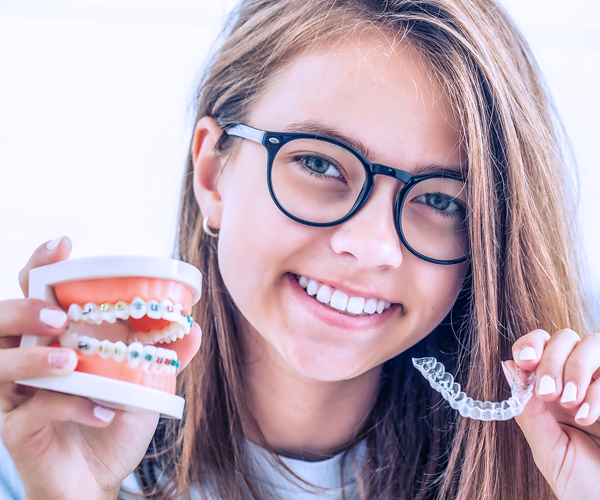If your teeth are crooked or you’ve been told you need braces or aligners, we have put together a guide which explains the difference between the two treatments.

If you’re dealing with crooked teeth or have been advised to use braces or teeth aligners, our blog outlines the key differences between these two teeth straightening treatments to help you choose the right option.
While a better-looking smile sounds like an obvious benefit resulting from having straight teeth, it can easily be dismissed as overly superficial. That said, there is more to it than just aesthetics. The main benefits include:
Superior oral hygiene
Straight teeth are easier to brush and floss, helping reduce the risk of gum disease, plaque build-up, and cavities.
Easier cleaning
Aligned teeth make everyday oral care more effective, supporting stronger teeth and healthier gums long-term.
Reduced tooth wear and injury risk
Proper alignment lowers the chance of teeth overlapping or protruding, helping prevent uneven wear and accidental fractures.
Improved speech clarity
Well-aligned teeth support proper pronunciation, making it easier to speak clearly and confidently.
Less strain, fewer headaches
Correcting jaw misalignment can ease muscle tension, reducing the risk of headaches and neck pain.
A boost in confidence and happiness
A straighter smile doesn’t just enhance your appearance — it can uplift your self-esteem and positively impact how you feel day-to-day.

In Melbourne, metal braces are the most traditional method, being both strong and able to treat extreme cases. Metal brackets and wires are used to gradually shift crooked teeth into proper alignment.
Ceramic braces allow for a more subtle solution, using brackets that blend with your tooth colour. This makes them less visible than metal braces while being just as efficient.
Lingual braces, on the other hand, aim to be invisible. The braces are fixed at the back of your teeth, hidden from view when you smile. They provide the same corrective benefits as traditional braces, only with a more subtle look.
Another popular choice is clear aligners, also sometimes called invisible braces. Invisalign or ClearCorrect are less painful than traditional braces. Not just aesthetically pleasing, this method allows you the freedom to take out the aligners for eating and improves oral hygiene better than wearing braces.
Braces
Braces are fixed in a position that tightens the teeth with wires. Over time, the orthodontist tightens the wire to provide pressure and slowly moves teeth into place as prescribed. The dental brace fixes all of the misalignment and bite imperfections in a variety of ways.
Teeth Aligners
If you’ve heard of Invisalign and its equivalent, ClearCorrect, these are clear aligners to straighten your teeth over time. Both are custom-made from clear, smooth plastic and fit tightly over your teeth. They are both removable so you can eat without worrying about food getting stuck under the aligners.
This brand uses a sequence of clear aligners to slowly place your teeth in an optimal position. These aligners are changed every two weeks. Invisalign aligners are recognised for their precise planning, digital treatment setup, and individualised treatment options.
Its functions are similar to Invisalign, with custom-made aligners designed to move teeth incrementally. However, ClearCorrect often offers different pricing options and a slightly different aligner material compared to Invisalign.

Traditional Braces
Pros:
Traditional braces are highly effective for serious alignment and bite issues. Because they’re fixed to the teeth, they work 24/7 and don’t need to be removed during meals. They also tend to be more affordable with a lower upfront cost.
Cons:
The metal brackets and wires are visible, and they can cause discomfort or irritation to the gums. They’re fixed in place, which makes cleaning more difficult, and they require more frequent dental visits.
Clear Aligners (Invisalign & ClearCorrect)
Pros:
Clear aligners are subtle and made from transparent plastic, making them an appealing option for those seeking a more discreet solution. They’re removable, which makes eating and oral hygiene much easier. They’re also custom-made to fit your teeth and typically require fewer in-chair appointments.
Cons:
They’re not suitable for severe alignment issues. You’ll need to remove them when eating or drinking anything other than water. They can be more expensive than traditional braces and require commitment — you’ll need to wear them for 20–22 hours a day for best results.
Teeth aligners are generally better in terms of visibility.
Made from clear plastic, they are virtually invisible, making them a popular choice for individuals seeking a discreet orthodontic solution. Traditional braces, with their metal brackets and wires, are more noticeable and can be a concern for those who prefer a less conspicuous treatment.
Teeth aligners are typically more comfortable than traditional braces.
They are custom-made from smooth plastic and fit snugly over your teeth without causing irritation. Braces, on the other hand, can cause discomfort due to the brackets and wires, which may irritate the gums and cheeks, especially after adjustments.
Teeth aligners offer a significant advantage in terms of hygiene.
Since they are removable, you can easily take them out to brush and floss, which helps maintain good oral health. Braces are fixed appliances, making it more challenging to clean around the brackets and wires, which can sometimes lead to plaque buildup and increased risk of tooth decay.
Teeth aligners are more convenient without diet restrictions.
They can be removed for eating and drinking, allowing for a normal diet without restrictions. Braces, being fixed, require patients to avoid certain foods and may involve more frequent visits for adjustments. Aligners generally require fewer dental visits, making them a more flexible option for those with busy schedules.
Choosing between braces and aligners depends on personal preferences and specific orthodontic needs. Both methods are effective for teeth straightening, but aligners offer additional benefits in terms of aesthetics, comfort, and convenience.
However, braces are a cost-effective solution for complex orthodontic cases.
Traditional braces are generally more affordable than clear aligners due to its use of standard materials like metal brackets and wires, which are less costly to produce compared to the custom-made, clear plastic trays used in aligners.
Additionally, braces do not require the same level of customisation and frequent replacements, further reducing the overall cost. As a result, they often provide a lower upfront cost, making them a cost-effective option for many patients. Traditional braces are also better suited for complex orthodontic cases, such as significant misalignments, severe bite issues, or rotated teeth, where clear aligners may not be effective. Orthodontists typically recommend braces for these challenging cases to achieve the best results.
Conclusion
Clear aligners are discreet, comfortable, and easy to maintain, making them ideal for those seeking a flexible orthodontic treatment. However, traditional braces are often more affordable and better suited for complex cases like severe misalignments.
If you’re considering orthodontic treatments in Melbourne, it may be time to speak to a professional to find out what’s best for you. Our Smile Place dentists are more than happy to support you as you take the next step to a brighter smile.
How much do braces or teeth aligners cost in Melbourne?
The cost varies depending on the treatment type and complexity of your case. Traditional metal braces usually range between $4,000 and $7,000, while clear aligners like Invisalign or ClearCorrect typically cost between $5,000 and $8,000. For a personalised quote, book a consultation or call Smile Place on (03) 9877 3724.
How long does treatment take?
Braces typically take between 18 to 36 months, depending on how complex the alignment is. Clear aligners usually require 12 to 24 months. Your dentist will give you a more accurate timeline after an initial consultation.
How often do I need to wear them?
Braces are fixed in place and worn 24/7 until treatment ends. Clear aligners need to be worn for 20 to 22 hours a day and should only be removed for eating, drinking, or brushing your teeth. Sticking to this schedule is key to seeing results.
Can I still eat my favourite foods?
With braces, you’ll need to avoid hard, sticky, or chewy foods that can damage brackets or wires. Clear aligners can be removed during meals, so there are no food restrictions — just be sure to clean them before putting them back in.
Does it hurt?
Both options can cause mild discomfort, especially after an adjustment or when switching to a new aligner. Braces may also cause temporary irritation to your cheeks or gums. This usually settles quickly and can be managed with over-the-counter pain relief.
Are they covered by insurance?
Many private health insurance plans offer partial cover for orthodontic treatments, but this varies by provider. It’s best to check with your insurer directly to confirm what’s included in your policy.